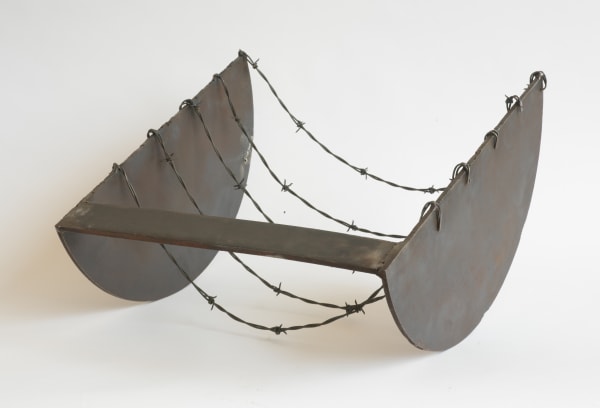Art Basel 2019
June 13–16, 2019
Booth P19
Messeplatz 10, 4005
Basel, Switzerland
Alexander Gray Associates presented recent and historical paintings and sculptures by Frank Bowling, Luis Camnitzer, Melvin Edwards, Coco Fusco, Harmony Hammond, Betty Parsons, Joan Semmel, Hassan Sharif, and Jack Whitten. Featuring a range of abstract and figurative works, the Gallery’s display foregrounded these artists’ commitment to challenging conceptual, formal, and sociopolitical conventions.
Since the 1960s, Frank Bowling’s painting practice has been defined by an integration of autobiography and postcolonial geopolitics into abstract compositions. In Morning Light (2019), Bowling crafts a work from two stacked planes of color. Suggesting a seascape, the composition expands on Bowling's 1980s abstract “waterscapes,” which are inspired by English masters like J.M.W. Turner. Inviting narratives around migration and diaspora via its strong horizon line, the work returns to themes the artist explored in earlier series, including in his 1960s Map Paintings, which are structured around his Afro-Caribbean roots and the legacies of colonialism.
Working at the height of Conceptualism, Luis Camnitzer produced a series of “object-boxes” that are meant to present the viewer with an ambiguous relationship between image and text. In Absent Line (1971–75), Camnitzer explores the ideas of self-referentiality and tautology, representing the same thing through both image and language. The artists spells out the word “absent line” and also visually portrays an absent line running through the text, prompting the viewer to question which element designated the other. Rainbow Statement (1973–75), presents a similar conundrum: Is the statement painted because of what it says, or does the painting prompt the statement? In these and other works Camnitzer aims to turn the viewer from a passive consumer of an artwork into an active participant.
Melvin Edwards’ sculptures reflect his engagement with the history of race, labor, and violence, as well as with themes of the African Diaspora. Shown in addition to his series of Lynch Fragments, Steel Life (After Winter) (2017) belongs to a series of “still-life” sculptures the artist constructs through the arrangement of steel tools, captured in stasis on a pedestal-based tableau. Earlier in his career, Edwards’s began exploring this notion of balance and the potential of movement, a concept first carried out in his series of Rockers, of which Ame Eghan (1975) belongs.
Artist and writer Coco Fusco presents her new series The Undiscovered Amerindians Tour (1992/2019). Consisting of a selection of documentary photographs from her iconic 1992–94 performance Two Undiscovered Amerindians Visit the West with Guillermo Gómez-Peña, the series revisits the performance’s historical impact 25 years after its original presentation. Satirizing the anthropological gaze, Fusco reflects on early-1990s multiculturalism and postcolonial activism.
Harmony Hammond’s paintings of the last decade participate in the narrative of modernist abstraction at the same time as they insist on an oppositional discourse of feminist and queer content. Near monochrome, many of these works, including Bandaged Grid #7 (2016-17), feature fields or grids of grommets. Layering patches of fabric over grommets, in this work, Hammond evokes a bandaged body. As she notes, “a bandage always implies a wound. A bandaged grid implies an interruption of the narrative of the modernist grid and therefore, an interruption of utopian egalitarian order.”
Betty Parsons was an abstract painter and sculptor who set out to capture the “invisible presence” of life. Her canvases combine the flat formalism of Color Field painting with allusions to nature, time, and the ephemeral. In Enter White I (1967), Parsons brings particular attention to line, using a linear order of alternating royal blue and yellow stripes, painted freehand in luminous layers of thin paint. Parsons’ approach to color was bold and intuitive, and often inspired by the natural landscape.
Since the 1970s, Joan Semmel has centered her practice around representations of the body from a female perspective, often focused on self-portraiture. In recent years she has returned to the brilliant colors first seen in the Sex Paintings for which she gained recognition early in her career. In Turning (2018) the twisting midsection of the body moves toward abstraction through an emphasis on expressive brushwork, while the right forearm is a concentrated area of color that traces back to Semmel’s training in Abstract Expressionism. Cross Over (1979), an example of Semmel’s earlier Echoing Images series, exemplifies her ongoing stylistic concerns and experimentation with both abstraction and realism. The series is characterized by the repetition of the main compositional figure in a smaller realist form and a second in a large expressionistic version.
First conceptualized in the 1980s, Hassan Sharif’s Objects are anchored in the process of weaving. Weaving, as he describes “requires a very simple handicraft that is at once repetitive and non-repetitive.” Responding to the landscape of material culture in the U.A.E. — which has undergone rapid social and economic changes since its independence in 1971— Sharif’s Objects, including Copper 1 (2012), are created from consumer products sourced from local markets and stores, including spoons, towels, floor mats, and electronic wiring.
A pioneer of abstract painting, Jack Whitten pushed the boundaries of the medium through innovative materials, methods, and processes. The First Landing Zone (1973) reveals Whitten’s interest in developing alternative approaches to painting that eschewed the painterly gestures of Abstract Expressionism. Created by building up layers of acrylic and drawing a tool across the surface—an afro pick, saw blade, rubber squeegee, etc.—this and other works in his Slab Paintings series challenged conventional understandings of art-making, introducing a process-based approach to abstraction.
About Art Basel
Art Basel show brings the international artworld together, with 291 of the world's leading galleries showing the works of over 4,000 artists. A full program of artworld talks takes place each day. Exhibitions and events are also offered by cultural institutions in Basel and the surrounding area, creating an exciting, region-wide art week.










